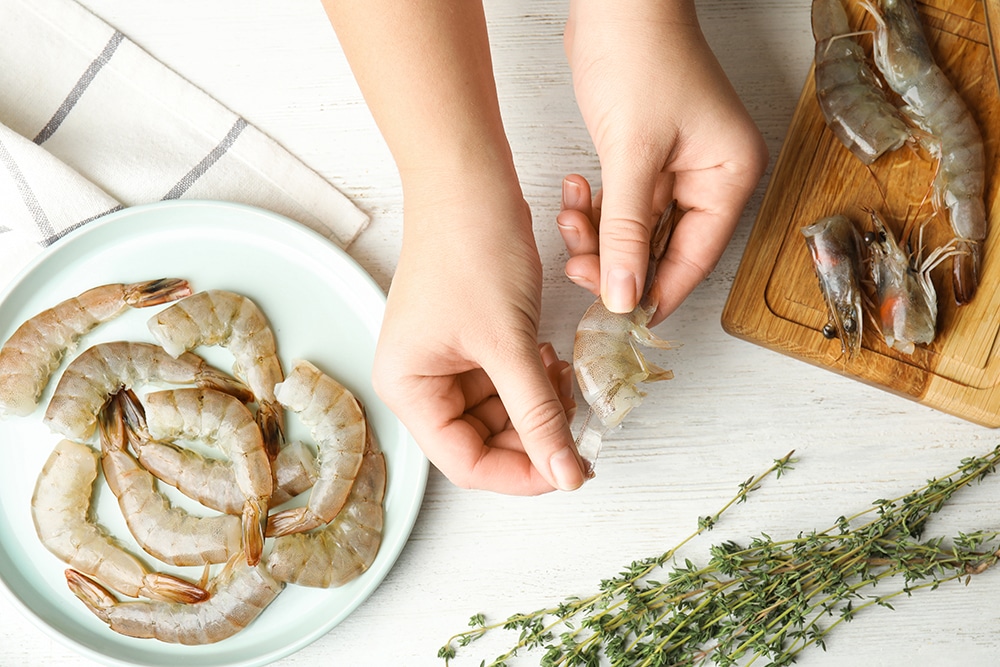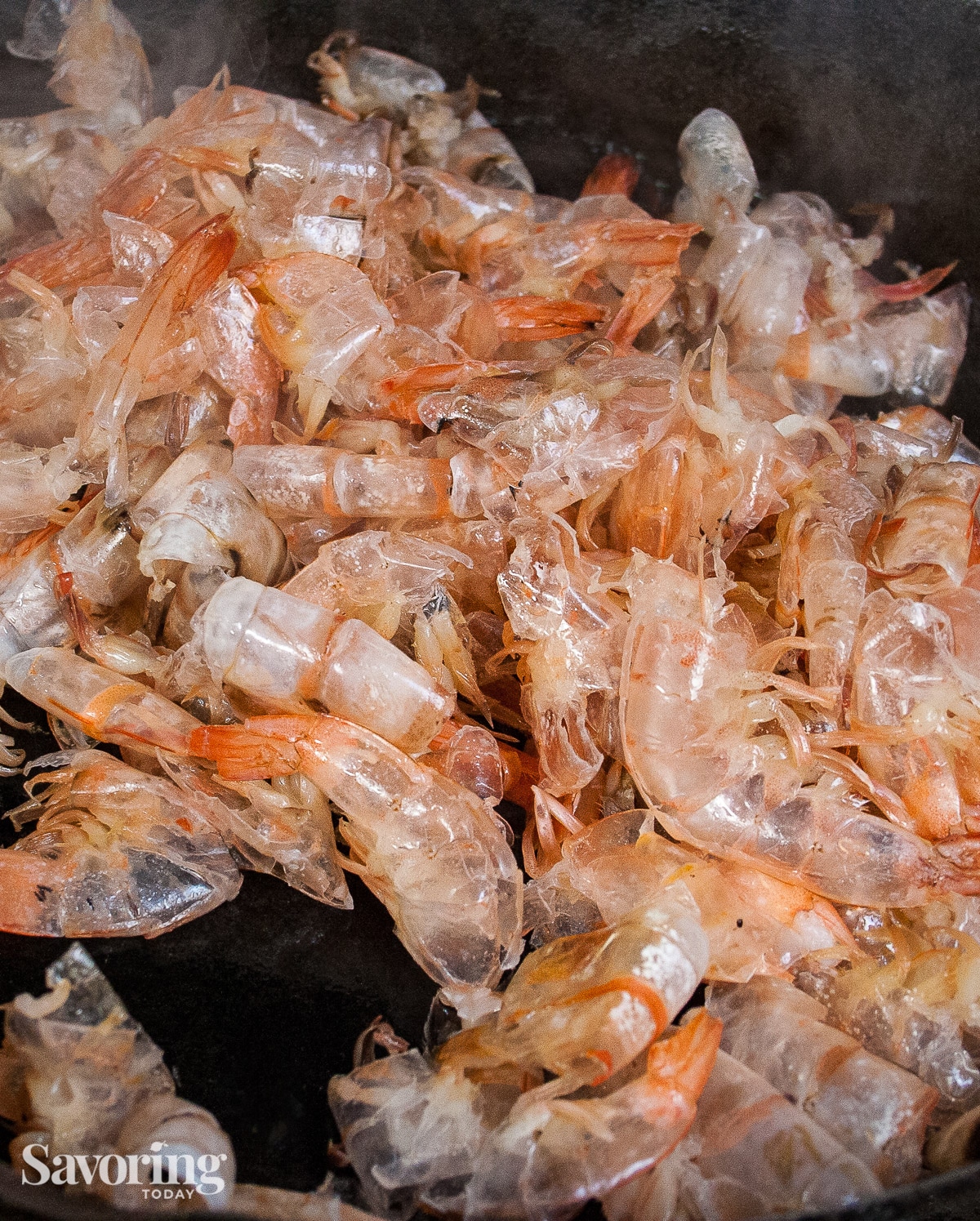Homemade shrimp stock is a crucial element in making the most delicious soups, gumbos, and stews.
It’s simple to make this stock, and it tastes great. Make a quick batch whenever you have fresh shrimp shells.
Homemade stock is a crucial element in delicious soups and stews. This recipe is inspired by Emeril’s Rich Shrimp Stock and is the base for Cajun Shrimp Stew.
Here in Colorado, it is not always easy to source shrimp with heads for the stock. The few shells from the shrimp for the Cajun stew were not enough for a great stock. To improvise, I asked for a fish head at the seafood counter, which they had.
Fish for most big grocery stores is now trimmed at a bigger facility and sent to them case-ready. It can depend on the time of year when scraps and carcasses are available, but a good fishmonger will usually have something in their freezer. It’s worth asking.
One to two pounds of shells to three to four quarts of filtered water is a good rule of thumb.
If you need shrimp stock quickly, you can use clam juice or crushed anchovies mixed with vegetable stock instead.
Homemade shrimp stock tastes best when kept in the fridge for three days or frozen for up to three months.
Store stock in a wide mouth jar (no shoulders), air-tight container, or freezer zip-type bag. If it’s still fresh, use it within three days. If not, freeze it for three months in containers with headspace or for up to six months in freezer bags without air.
Shrimp are delicious, but preparing them often leaves you with piles of leftover heads and shells. While the temptation is to toss them in the trash, these shrimp parts are actually little treasure troves of flavor. Instead of wasting them, there are many clever ways to make the most of shrimp heads
Get to Know the Shrimp Head
First, let’s take a quick look at the anatomy of a shrimp head
-
Eyes – Shrimp have compound eyes that sit on little stalks. They provide excellent vision.
-
Antennae – Help shrimp sense their surroundings.
-
Mouthparts – Includes mandibles for grasping food.
-
Carapace – The hard upper shell that covers the head.
-
Legs – Attach to the underside.
While we normally only eat the tails, the heads contain juices that lend great seafood flavor. The shells also contain glucosamine, nutrients, and collagen.
Don’t Toss Them – Make Stock!
The simplest way to save those shrimp heads is to make a stock. Simmer the heads and shells in water to extract their essence. Strain out the solids and you’re left with a richly flavored broth.
Shrimp stock forms the base for:
- Seafood risottos
- Soups – shrimp bisque, chowders
- Sauces – etouffee, marinara
- Stews like jambalaya
- Paella
Tip: Roast shells before simmering to bring out deeper flavor. Add aromatics like onion, garlic, celery, peppercorns, bay leaf, and thyme.
Turn Them Into a Flavored Butter
Combining shrimp heads into a compound butter makes a luxurious, savory spread. Blend sauteed heads into room temperature butter. Chill, then slice and melt over vegetables, pasta, or fish.
Ways to use shrimp butter:
-
Topping for grilled shrimp, scallops, or white fish fillets.
-
Flavorful addition to garlic bread.
-
Whisked into pan sauces.
-
Melted over steamed veggies like asparagus, broccoli, and carrots.
Make a Potent Shellfish Oil
Steeping shrimp shells in oil extracts their essences. It makes a beautifully orange-hued, flavor-packed oil. Drizzle over pasta, salads, grilled meats, or bread.
To make:
-
Gently cook shells to dry out moisture.
-
Combine with neutral oil and aromatics in a sealed jar.
-
Simmer jar in water bath for 1 hour.
-
Strain and refrigerate.
Powder Them for Nutrition
Grind dried shells into a fine powder to sprinkle over foods. It provides natural glucosamine, calcium, and other nutrients. The mild seafood flavor enhances dishes like:
- Fried rice or pasta
- Seafood chowders
- Sprinkle on fish before pan searing
Roast shells well before grinding to remove moisture and improve shelf life. Store the powder in an airtight container.
Make a Savory Shellfish Jelly
Simmering shells into a stock then chilling it solid makes an elegant accompaniment for seafood. For an extra touch, stud the jelly with cooked shrimp or herbs before chilling. Spread on crackers or serve with appetizers.
Use Them for Crunchy Coating
For a textural crunch, try baking leftover shells and grinding them into a coarse crumb. Coat fish fillets or shrimp with mayo or batter then roll them in the shell coating before frying. The shell crumbs create a satisfying crispy crust.
Shellfish Sauce Thickener
In place of cornstarch or flour, puree shrimp shells into a smooth paste. Whisk the shell puree into sauce at the end of cooking to thicken and add body and seafood essence. Shells are great for thickening and flavoring:
- Cream sauces
- Gravies
- Bisques
- Chowders
So next time you cook shrimp, hold onto those heads and shells! With a little creativity, you can transform the “trash” into some amazing recipes. Your cooking will be more sustainable, nutritious, and packed with bonus flavor.

Strain and Cool
- Grab a rimmed baking sheet for the strained contents so they can cool completely before being thrown away when you’re ready to strain the stock.
- Take a 2 or 4-cup scoop and move the contents to a strainer that is precariously balanced over a bowl instead of trying to pour from a heavy pot with splashy hot bits.
- When you strain, don’t press on the contents; let gravity do the work to keep small bits of sediment from pushing through. *If the taste and texture sound good, you can eat the strained meat and vegetables that are left over.
- Cool the stock as quickly as possible if you’re not going to use it right away. Put it in the sink in a bath of ice water or add a few ice cubes and pour it into a shallow container. Allow it to cool for two to three hours. Don’t put hot stock in the fridge; it will cool the whole fridge down to levels that could be dangerous.
- Homemade shrimp stock tastes best when kept in the fridge for three days or frozen for three months.
- You can freeze the stock in different amounts, like ice cube tray squares (tablespoons), 1/2 cup, 1 cup, or 2 cups. For soups, 6 to 8 cups is the best amount.
- Not all the way to the top of the containers and jars should be filled with liquid, leaving an inch of space for it to grow. You should only put things in the freezer in glass jars with straight sides (no shoulders).
- It’s best to store food in freezer bags that can lie flat. Remove as much air as possible before sealing. Spread the filled bags out flat on a baking sheet with a lip so they don’t stick together.

- Freezing food in zip-top bags: Food in a freezer bag will almost always leak when it thaws, and I have learned that bags can’t be trusted—there’s always a weak spot.
- It’s important not to fill the bags too much—2-4 cups per quart bag and 6-8 cups per gallon bag works well and doesn’t put too much stress on the seams.
- After straining out the solids and throwing them away, cut the stock even more to save space in the freezer. If you need to, add water to the defrosted stock to make it less concentrated.
- Don’t defrost in a bowl of water unless you want your stock to become watered down, and don’t trust the corners of the bag. Instead, defrost on a pan with a lip to catch any leaks.
How to Boost Flavor in Fish Stock Without Fish Heads
If you don’t have enough shells, don’t worry! You can still make shrimp stock taste better by adding a little of the following:
- fish sauce
- bonito (we use this in Pad Thai too!)
- clam juice
- mashed anchovy
- fish base bouillon
Note: All of these flavor enhancers have sodium in them, so if you use any of them, leave out the salt in the recipe or add it at the end to taste the stock.
Giving the stock a few more minutes to reduce will also make the flavors stronger, but you might want to open a window so the smell doesn’t stay inside. (Just sayin’).

This post may contain affiliate links. See our disclosure policy for more information.
